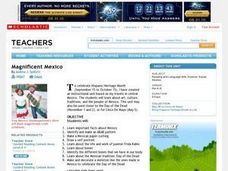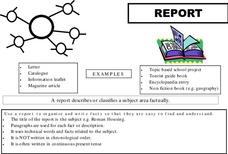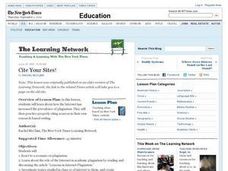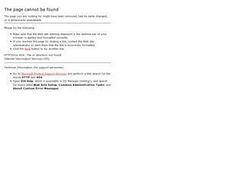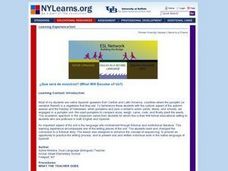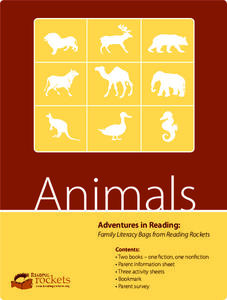Curated OER
Library Lesson Plan: Table of Contents
Third graders create a table of contents. In this library skills lesson, 3rd graders read Welcome to the White House and use the provided worksheet to create a table of contents for the book.
Curated OER
Finding Your Story: Helping Students Begin Their Memoir
Students write their memoir. In this memoir lesson plan, students study the differences between an autobiography and a memoir. Students construct an outline as the basis for their memoir.
Curated OER
Establish the Theme
Second graders explore the topic of nature. For this detective lesson, 2nd graders review non-fiction materials on nature and identify text, headings, diagrams, graphs, to establish the theme of the book.
Curated OER
Magnificent Mexico
Students complete a variety of activities in a unit about the art, culture, and traditions of Mexico. They read books about the Day of the Dead, create a skeleton puppet, and create a traditional Mexican tissue paper cutting. Students...
PBS
Reading Adventure Pack: Music
Music is the focus of the reading adventure pack. After reading, pupils complete hands-on activities. Scholars use household items to make shakers and cymbals. They listen to eclectic music by turning on the radio, borrowing music from...
Curated OER
Libraries Are the Place to Be
Celebrate National Library Week by discovering all that your local library and the Library of Congress have to offer.
Curated OER
Non Fiction Posters
A set of very useful posters (in PDF) describing different types of non-fiction texts is here for you. While there isn't an activity, per se, in these worksheets, they could be used as a handy reference for learners who are engaging in...
Curated OER
Main Idea in Informational Text
Readers identify main ideas and supporting details using informational texts. For this literacy lesson, they make predictions and read the text to find the main ideas. They use a table diagram to define the main idea and supporting...
Curated OER
Cite Your Sites
What information would you find in an almanac that you would not find in an atlas? What is the difference between a dictionary and a thesaurus? Using a Cite Your Sites worksheet on which they record their observations, groups participate...
Curated OER
My Family
Students read a story entitled, "My Family." They predict what they expect to they family will be doing in the book. Students explore strategies for decoding unfamiliar words. They brainstorm things family members might teach each other....
Curated OER
What It Means to Be an American Indian
Students analyze primary source documents and evaluate historical evidence to find consequences of the policies that were adopted from the 1830s to today regarding Native American Indians.
Curated OER
?Que ser de nosotros? (What Will Become of Us?)
Students discuss uses of a pumpkin. They fill out graphic organizers. Students listen as the teacher reads a story, and participate by repeating sounds the objects make as the story progresses. One student narrates the story while others...
Curated OER
Under the Sea
Students identify and interpret that non-fiction books have features like a table of contents, a glossary, and an index, which can efficiently help them find information. They also identify how to narrow the search for information by...
Curated OER
Radical Reads
Young scholars recreate an "American Idol" contest in which they present their favorite books to their classmates using arguments for and excerpts from the books. Following the presentation, students will be polled and the least popular...
Curated OER
Read It, Don't Eat It!
Learners complete activities based on the book Read It, Don't Eat It! For this library rules lesson, students are read a story that illustrates library rules, then match the rules with pictures and complete a maze.
Curated OER
Library Curriculum: What Would a Wonderful Library Be Like?
Second graders complete a KWL chart about libraries. They create a book using writing patterns of a particular author. Students decide criteria for awarding the Second Grade Librarian Award to books in the classroom library, and use a...
PBS
Reading Adventure Pack: Animals
Scholars explore the animal kingdom with help from two texts, Blueberries for Sal by Robert McCloskey and A Bed for the Winter by Karen Wallace. The literature and informational text set the learning stage for thoughtful discussion and...
PBS
Arthur’s World Neighborhood: Bibliography for Kids
Support young learners as they expand their cultural awareness with this list of children's literature on countries from around the globe. Including both fictional and non-fictional texts. This resource will help...
National Book Network
A Day with No Crayons
Colors and crayons are the inspiration for this collection of activities! Kids illustrate the real world, come up with their own names for colors, make their own crayons (with teacher assistance), create artwork they can eat, and more.
Scholastic
The First Thanksgiving Feast for Grades 6–8
It's time for the feast! Young historians complete their study of the First Thanksgiving by completing an online activity, watching a slideshow, and examining a First Thanksgiving timeline. After answering text-dependent questions to...
2012 Teaching Resources
Analyzing Character Traits
Character analysis becomes easy with a 24-page packet packed with mini-lessons, graphic organizers, and activities. A must-have for your curriculum library.
Curated OER
Author, Author!
Third graders, in groups, select and research a favorite studenT author or illustrator. They answer questions about the author, conduct research and prepare a PowerPoint presentation with their findings.
Curated OER
Doing Dewey Decimal
Students examine the Dewey Decimal System and locate books in the nonfiction section. They examine a shelf of books and try to determine how the books are arranged, then watch a short video "Media Mania." Students then match construction...
Curated OER
Creating Comic Strips
Students recognize the elements needed to create a comic strip. In this comic strip lesson, student understand that comic strips need words and pictures. Students find differences and similarities in comic strips. Students describe how...





